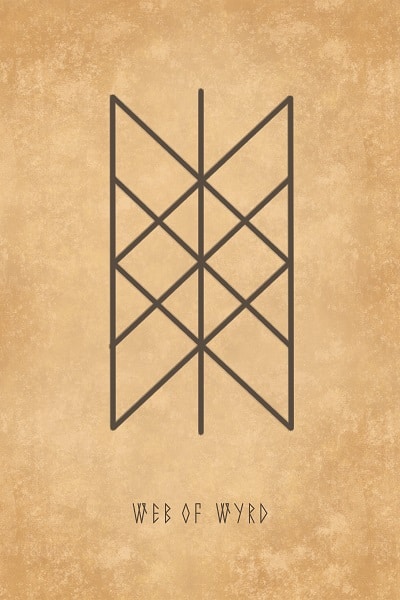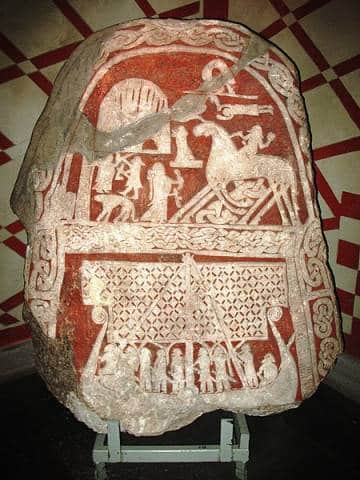The Valkyries were Odins’ maidens tasked with collecting the Vikings fallen in war to join the ranks of the Einherjar. However, they didn’t only gather the fallen, they weighed in, manipulating the course of battles on behalf of Odin. All while singing the song of the spear.
This process is described in all its gruesome detail in a part of Njal’s saga found in chapter 156. In it, we hear from a firsthand witness who sees the Valkyries enter a cottage where he sees them setting up a weaving loom.
For those of you not intimately familiar with a handloom or how one weaves, the following are some quick points.
A loom is a large frame used for weaving, in the olden times they could fill a whole room. Often there might be a separate weaving cottage, a small house only for the process of weaving. In this tale, where twelve valkyries are working the loom it would be a monstrously large contraption.
A loom is set up with thread for weaving where the thread running lengthwise is called the warp. The thread that is passed back and forth, crosswise to the warp is called the weft, or woof. That thread is attached to a shuttle, the “needle” used for passing the thread back and forth across the warp.
Together, the warp and the weft/woof become the web that is woven. Keeping the warp tight there were counterweights used and the yarn was spun up on reels feeding into the loom.
Weaving fates of men and the Web of Wyrd concept
Just as the Norns weave the fate of men at their birth, the Valkyries seem to also be weaving.
Deciding the course of the war, choosing who will fall and who will live was also woven. Not with golden thread, however, but with bloody entrails.

The image of a tapestry of life’s events woven together is one used several times in the old texts. Although a modern concept, the Web of Wyrd encapsulates this weaving. Interestingly, in a translation by Lee Hollander from 1902, he has translated one of the kennings for valkyries as weird sisters. Weird, coming from the Old English word wyrd, meaning fate.
Outside of man’s control, both life and death are predestined and only to be accepted. While leading an honorable life, or not, is an individual choice, the fate of the Vikings is out of their hands.
However, while the Norns could not be reasoned or bargained with, Odin was much more pragmatic and transactional. To him, the kings and warlords could prey and give offerings in order to win his favor.
With Odin on your side, the Valkyries would work their loom, sealing the fates of your enemies making you victorious. As we will learn, Odin and his Valkyries played a role in the Battle of Clontarf outside Dublin in 1014.
It was a major battle between the Irish king Brian Boru against a coalition of Viking warriors. In the end, the Irish won, but king Boru was among those who lost their lives. A big and particularly bloody battle it is believed several thousand might have died. A good day for Odin indeed.
The Valkyries song – “The Song of the Spear”

I have adapted this translation slightly from its Old English into a more modern form for easier reading. This particular poem/song in its original form has a lot of “kennings” (basically calling something/someone by a description, rather than their name). The kennings and the freedom, or challenge, they pose have led to a number of translations with quite large differences.
On Good Friday it happened in Caithness that a man whose name was Daurrud went out. He saw people riding twelve together to a cottage, and there they were all lost to his sight. He went to that cottage and looked in through a window slit that was in it, and saw that there were women inside, and they had set up a loom. Men’s heads were the weights, and men’s entrails were the warp and weft, a sword was the shuttle, and the reels were arrows.
They sang these songs, and he learnt them by heart–
The Song of the Spear
Verse 1.
Warp is stretched
For those falling in battle
The weft in the loom
is raining blood.
The fight is near
A gray weave
of men is made
Under maidens swift fingers,
Our warp bloodred
Our weft corpse blue
Verse 2.
The web is woven
With guts of men,
The warp held taught
With the heads of men
Blood drenched spears
as loom rods.
The warp beam iron covered,
We weave with our swords.
Verse 3.
Hildr goes to weave
and Hjǫrþrimul,
Sanngríðr and Svipul,
with drawn swords.
Spear will snap.
shields will break,
and helmet-gnawer
ruin shields.
Verse 4.
Weaving, weaving
the web of spears,
For the young king,
foredoomed he is.
We move forward,
stepping into the fray
where our friends
weapons clash.
Verse 5.
Weaving, weaving
the web of spears,
then the young king
we follow.
Gunnr and Göndul,
Who guarded him
See the warriors
Bloody shields.
Verse 6.
Weaving, weaving
the web of spears,
Where banners fly
over able warriors,
Let us not,
forsake his life
only Valkyries
choose the slain.
Verse 7.
The people will
rule these lands,
who before
settled the peninsulas.
I declare the rich king
to be dead.
Now on the spear
the earl sank down.
Verse 8.
And the Irish
will endure sorrow
Which will never fade
for the warriors.
Now our web is woven,
The battlefield is red,
news of the fallen will travel
across the land.
Verse 9.
Now it is a horrible sight,
looking around
As blood red clouds
cross the sky.
The air itself is colored
in men’s blood
When this plan
has been sung
Verse 10.
We spoke well
of the young king
Many victory songs
we will sing.
Let all who listen learn,
our spear weaving song
Share it and
entertain others.
Verse 11.
Now we ride hard
our bareback horses,
with drawn swords
far from here.
Then they pulled down the web and tore it apart, each kept the piece she had hold of.
Featured Image Credit: Hugh Frazer, Public domain, via Wikimedia Commons
